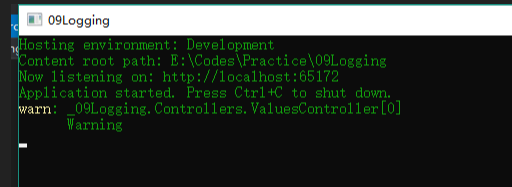.Net Core中的日志组件(Logging)
1、介绍
Logging组件是微软实现的日志记录组件包括控制台(Console)、调试(Debug)、事件日志(EventLog)和TraceSource,但是没有实现最常用用的文件记录日志功能(可以用其他第三方的如NLog、Log4Net。之前写过NLog使用的文章)。
2、默认配置
新建.Net Core Web Api项目,添加下面代码。
[Route("api/[controller]")]
public class ValuesController : Controller
{
ILogger<ValuesController> logger;
//构造函数注入Logger
public ValuesController(ILogger<ValuesController> logger)
{
this.logger = logger;
}
[HttpGet]
public IEnumerable<string> Get()
{
logger.LogWarning("Warning");
return new string[] { "value1", "value2" };
}
}
运行结果如下:

我刚开始接触的时候,我就有一个疑问我根本没有配置关于Logger的任何代码,仅仅写了注入,为什么会起作用呢?最后我发现其实是在Program类中使用了微软默认的配置。
public class Program
{
public static void Main(string[] args)
{
BuildWebHost(args).Run();
}
public static IWebHost BuildWebHost(string[] args) =>
WebHost.CreateDefaultBuilder(args)//在这里使用了默认配置
.UseStartup<Startup>()
.Build();
}
下面为CreateDefaultBuilder方法的部分源码,整个源码在 https://github.com/aspnet/MetaPackages,可以看出在使用模板创建项目的时候,默认添加了控制台和调试日志组件,并从appsettings.json中读取配置。
builder.UseKestrel((builderContext, options) =>
{
options.Configure(builderContext.Configuration.GetSection("Kestrel"));
})
.ConfigureAppConfiguration((hostingContext, config) =>
{
var env = hostingContext.HostingEnvironment;
//加载appsettings.json文件 使用模板创建的项目,会生成一个配置文件,配置文件中包含Logging的配置项
config.AddJsonFile("appsettings.json", optional: true, reloadOnChange: true)
.AddJsonFile($"appsettings.{env.EnvironmentName}.json", optional: true, reloadOnChange: true);
.......
})
.ConfigureLogging((hostingContext, logging) =>
{
//从appsettings.json中获取Logging的配置
logging.AddConfiguration(hostingContext.Configuration.GetSection("Logging"));
//添加控制台输出
logging.AddConsole();
//添加调试输出
logging.AddDebug();
})
3、建立自己的Logging配置
首先修改Program类
public class Program
{
public static void Main(string[] args)
{
//指定配置文件路径
var config = new ConfigurationBuilder()
.SetBasePath(Directory.GetCurrentDirectory())//设置基础路径
.AddJsonFile($"appsettings.json", true, true)//加载配置文件
.AddJsonFile($"appsettings.{EnvironmentName.Development}.json", true, true)
.Build(); var host = new WebHostBuilder()
.UseKestrel()
.UseStartup<Startup>()
.UseContentRoot(Directory.GetCurrentDirectory())
.UseConfiguration(config)//使用配置
.UseUrls(config["AppSettings:Url"])//从配置中读取 程序监听的端口号
.UseEnvironment(EnvironmentName.Development)//如果加载了多个环境配置,可以设置使用哪个配置 一般有测试环境、正式环境
//.ConfigureLogging((hostingCotext, logging) => //第一种配置方法 直接在webHostBuilder建立时配置 不需要修改下面的Startup代码
//{
// logging.AddConfiguration(hostingCotext.Configuration.GetSection("Logging"));
// logging.AddConsole();
//})
.Build();
host.Run();
}
}
修改Startup类如下面,此类的执行顺序为 Startup构造函数 > ConfigureServices > Configure
public class Startup
{
public IConfiguration Configuration { get; private set; }
public IHostingEnvironment HostingEnvironment { get; private set; }
//在构造函数中注入 IHostingEnvironment和IConfiguration,配置已经在Program中设置了,注入后就可以获取配置文件的数据
public Startup(IHostingEnvironment env, IConfiguration config)
{
HostingEnvironment = env;
Configuration = config;
}
public void ConfigureServices(IServiceCollection services)
{
services.AddMvc();
//第二种配置 也可以这样加上日志功能,不用下面的注入
//services.AddLogging(builder =>
//{
// builder.AddConfiguration(Configuration.GetSection("Logging"))
// .AddConsole();
//});
}
//注入ILoggerFactory
public void Configure(IApplicationBuilder app, IHostingEnvironment env, ILoggerFactory loggerFactory)
{
if (env.IsDevelopment())
{
app.UseDeveloperExceptionPage();
}
//第三种配置 注入ILogggerFactory,然后配置参数
//添加控制台输出
loggerFactory.AddConsole(Configuration.GetSection("Logging"));
//添加调试输出
loggerFactory.AddDebug();
app.UseMvc();
}
}
这种结构就比较清晰明了。
4、Logging源码解析
三种配置其实都是为了注入日志相关的服务,但是调用的方法稍有不同。现在我们以第二种配置来详细看看其注入过程。首先调用AddLogging方法,其实现源码如下:
public static IServiceCollection AddLogging(this IServiceCollection services, Action<ILoggingBuilder> configure)
{
services.AddOptions();//这里会注入最基础的5个服务 option相关服务只要是跟配置文件相关,通过Option服务获取相关配置文件参数参数 services.TryAdd(ServiceDescriptor.Singleton<ILoggerFactory, LoggerFactory>());
services.TryAdd(ServiceDescriptor.Singleton(typeof(ILogger<>), typeof(Logger<>)));
services.TryAddEnumerable(ServiceDescriptor.Singleton<IConfigureOptions<LoggerFilterOptions>>(new DefaultLoggerLevelConfigureOptions(LogLevel.Information))); configure(new LoggingBuilder(services));
return services;
}
接着会调用AddConfiguration
public static ILoggingBuilder AddConfiguration(this ILoggingBuilder builder, IConfiguration configuration)
{
builder.AddConfiguration();
//下面为AddConfiguration的实现
public static void AddConfiguration(this ILoggingBuilder builder)
{
builder.Services.TryAddSingleton<ILoggerProviderConfigurationFactory, LoggerProviderConfigurationFactory>();
builder.Services.TryAddSingleton(typeof(ILoggerProviderConfiguration<>), typeof(LoggerProviderConfiguration<>));
}
builder.Services.AddSingleton<IConfigureOptions<LoggerFilterOptions>>(new LoggerFilterConfigureOptions(configuration));
builder.Services.AddSingleton<IOptionsChangeTokenSource<LoggerFilterOptions>>(new ConfigurationChangeTokenSource<LoggerFilterOptions>(configuration));
builder.Services.AddSingleton(new LoggingConfiguration(configuration)); return builder;
}
下面来看打印日志的具体实现:
public void Log<TState>(LogLevel logLevel, EventId eventId, TState state, Exception exception, Func<TState, Exception, string> formatter)
{
var loggers = Loggers;
List<Exception> exceptions = null;
//loggers为LoggerInformation数组,如果你在Startup中添加了Console、Deubg日志功能了,那loggers数组值有2个,就是它俩。
foreach (var loggerInfo in loggers)
{ //循环遍历每一种日志打印,如果满足些日子的条件,才执行打印log方法。比如某一个日志等级为Info,
//但是Console配置的最低打印等级为Warning,Debug配置的最低打印等级为Debug
//则Console中不会打印,Debug中会被打印
if (!loggerInfo.IsEnabled(logLevel))
{
continue;
}
try
{
//每一种类型的日志,对应的打印方法不同。执行对应的打印方法
loggerInfo.Logger.Log(logLevel, eventId, state, exception, formatter);
}
catch (Exception ex)
{
if (exceptions == null)
{
exceptions = new List<Exception>();
} exceptions.Add(ex);
}
}
}
下面具体看一下Console的打印实现:
首先ConsoleLogger实现了ILogger的Log方法,并在方法中调用WriteMessage方法
public void Log<TState>(LogLevel logLevel, EventId eventId, TState state, Exception exception, Func<TState, Exception, string> formatter)
{
//代码太多 我就省略一些判空代码
var message = formatter(state, exception); if (!string.IsNullOrEmpty(message) || exception != null)
{
WriteMessage(logLevel, Name, eventId.Id, message, exception);
}
} public virtual void WriteMessage(LogLevel logLevel, string logName, int eventId, string message, Exception exception)
{
.......
if (logBuilder.Length > )
{
var hasLevel = !string.IsNullOrEmpty(logLevelString);
//这里是主要的代码实现,可以看到,并没有写日志的代码,而是将日志打入到一个BlockingCollection<LogMessageEntry>队列中
//这里需要指出 BlockingCollection是线程安全的集合,多个线程同时访问,不会发生数据混乱。
_queueProcessor.EnqueueMessage(new LogMessageEntry()
{
Message = logBuilder.ToString(),
MessageColor = DefaultConsoleColor,
LevelString = hasLevel ? logLevelString : null,
LevelBackground = hasLevel ? logLevelColors.Background : null,
LevelForeground = hasLevel ? logLevelColors.Foreground : null
});
}
......
}
下面看日志被放入队列后的具体实现:
public class ConsoleLoggerProcessor : IDisposable
{
private const int _maxQueuedMessages = 1024;
private readonly BlockingCollection<LogMessageEntry> _messageQueue = new BlockingCollection<LogMessageEntry>(_maxQueuedMessages);
private readonly Thread _outputThread;
public IConsole Console;
public ConsoleLoggerProcessor()
{
//在构造函数中启动一个线程,执行ProcessLogQueue方法
//从下面ProcessLogQueue方法可以看出,是循环遍历集合,将集合中的数据打印
_outputThread = new Thread(ProcessLogQueue)
{
IsBackground = true,
Name = "Console logger queue processing thread"public virtual void EnqueueMessage(LogMessageEntry message)
{
if (!_messageQueue.IsAddingCompleted)
{
try
{
_messageQueue.Add(message);
return;
}
catch (InvalidOperationException) { }
}
WriteMessage(message);
}
internal virtual void WriteMessage(LogMessageEntry message)
{
if (message.LevelString != null)
{
Console.Write(message.LevelString, message.LevelBackground, message.LevelForeground);
}
Console.Write(message.Message, message.MessageColor, message.MessageColor);
Console.Flush();
}
private void ProcessLogQueue()
{
try
{
//GetConsumingEnumerable()方法比较特殊,当集合中没有值时,会阻塞自己,一但有值了,直到集合中又有元素继续遍历
foreach (var message in _messageQueue.GetConsumingEnumerable())
{
WriteMessage(message);
}
}
catch
{
try
{
_messageQueue.CompleteAdding();
}
catch { }
}
}
}
.Net Core中的日志组件(Logging)的更多相关文章
- 玩转ASP.NET Core中的日志组件
简介 日志组件,作为程序员使用频率最高的组件,给程序员开发调试程序提供了必要的信息.ASP.NET Core中内置了一个通用日志接口ILogger,并实现了多种内置的日志提供器,例如 Console ...
- .NET Core 中的日志与分布式链路追踪
目录 .NET Core 中的日志与分布式链路追踪 .NET Core 中的日志 控制台输出 非侵入式日志 Microsoft.Extensions.Logging ILoggerFactory IL ...
- (14)ASP.NET Core 中的日志记录
1.前言 ASP.NET Core支持适用于各种内置和第三方日志记录提供应用程序的日志记录API.本文介绍了如何将日志记录API与内置提供应用程序一起使用. 2.添加日志提供程序 日志记录提供应用程序 ...
- .NET Core中的验证组件FluentValidation的实战分享
今天有人问我能不能出一篇FluentValidation的教程,刚好今天在实现我们的.NET Core实战项目之CMS的修改密码部分的功能中有用到FluentValidation,所以就以修改用户密码 ...
- Asp.Net Core中利用Seq组件展示结构化日志功能
在一次.Net Core小项目的开发中,掌握的不够深入,对日志记录并没有好好利用,以至于一出现异常问题,都得跑动服务器上查看,那时一度怀疑自己肯定没学好,不然这一块日志不可能需要自己扒服务器日志来查看 ...
- ASP.NET Core 中的日志记录
目录 内置日志的使用 使用Nlog 集成ELK 参考 内置日志的使用 Logger 是 asp .net core 的内置 service,所以我们就不需要在ConfigureService里面注册了 ...
- java中的日志组件-log4j
1.为什么使用日志组件 Log4J是Apache的一个开放源代码项目,它是一个日志操作包,通过使用Log4J,可以指定日志信息输出的目的地,如控制台.文件.CUI组件.NT的事件记录器:还可以控制每一 ...
- Python中的日志管理Logging模块
1.基本的用法 import logging logging.debug('This is debug message') logging.info('This is info message') l ...
- .NET Core中的数据保护组件
原文地址: PREVENTING INSECURE OBJECT REFERENCES IN ASP.NET CORE 2.0 作者: Tahir Naushad 背景介绍 在 OWASP(开放式 W ...
随机推荐
- boost asio 学习(九) boost::asio 网络封装
http://www.gamedev.net/blog/950/entry-2249317-a-guide-to-getting- started-with-boostasio?pg=10 9. A ...
- HQL-Query接口
org.hibernate.Query接口 1.Query接口定义有执行查询的方法(完成HQL语句的解析和执行过程并返回查询结果,就像SQL语句没了JDBC接口就成了一个普通的字符串变量) 2.Que ...
- Transform Model
self attention Q=K=V :输入一个句子,那么里面的每个词都要和该句子中的所有词进行attention计算,目的是要学习句子内部词之间的依赖关系,捕获句子的内部结构. 首先,要buil ...
- 18个分形图形的GIF动画演示
这里提供18个几何线段分形的GIF动画图像.图形颜色是白色,背景色为黑色,使用最基本的黑与白以表现分形图形. (1)科赫(Koch)雪花 (2)列维(levy)曲线 (3)龙形曲线(Drago ...
- extern的使用详解(多文件编程)——C语言
extern——关键字 extern是C语言中的一个关键字,一般用在变量名前或函数名前,作用是用来说明“此变量/函数是在别处定义的,要在此处引用”,extern这个关键字大部分读者应该是在变量的存储类 ...
- ie被hao.360劫持的解决方法
概述 之前无意中发现ie被hao.360劫持了,只要打开网址就会跳到hao.360,然后显示网络错误.网上试了几种解决方法,都不行,最后被我用重置ie浏览器的方法解决了.我总结了一下,把各种方案都记下 ...
- maven 下载镜像文件卡,下载pom文件慢的问题
问题原因: maven默认的镜像库URL为 http://maven.net.cn/content/groups/public/ 由于网络原因,可能导致响应速度超级慢,或者无法效应: 解决方法: 配置 ...
- 双系统Ubuntu无法访问Win10磁盘分区解决方法
今天在linux下打开win的NTFS硬盘总是提示出错了,而且是全部的NTFS盘都出错,其中sda3错误显示如下: Error mounting /dev/sda3 at /media/struggl ...
- Angular使用总结 --- 通过指令动态添加组件
之前自己写的公共组件,都是会先引入,需要调起的时候再通过service控制公共组件状态.值.回调函数什么的.但是有一些场景不适合这种方式,还是动态添加组件更加好.通过写过的一个小组件来总结下. 创建组 ...
- Liferay7 BPM门户开发之23: 了解内置工作流(Kaleo Workflow)
Liferay内置的工作流是企业版的功能,虽然简单粗糙,但依然不支持社区版.既然要用更强大的Activiti来替代它,那就非常有必要学习一下内置工作流的一些思想,以便借鉴. 它的特点: 实体的工作流操 ...
